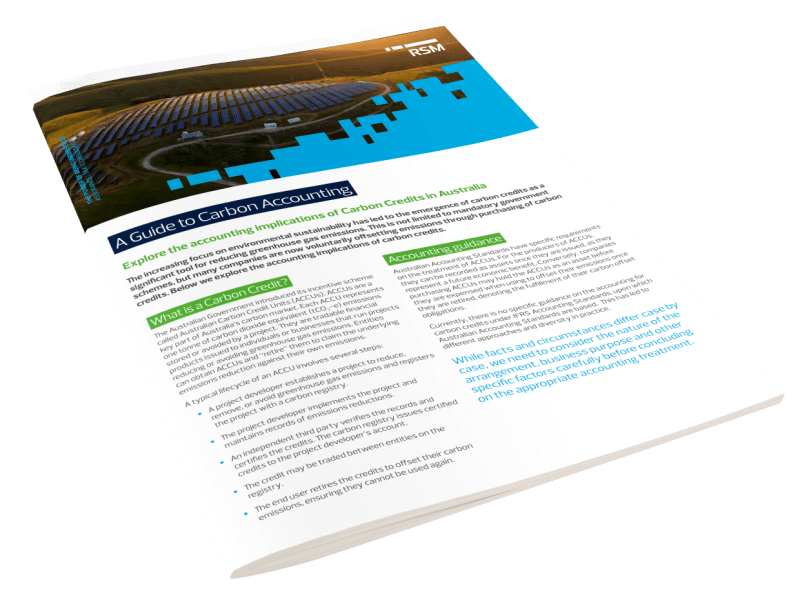AUTHORS

The first new IFRS Standard for 7 years, IFRS 18, is set to overhaul the way that income and expenses are presented in financial statements. Key changes are:
- A defined structure for the statement of profit or loss, including a new mandatory subtotal of “operating profit.”
- A new requirement to disclose management-defined performance measures, and to reconcile any non-GAAP measures back to IFRS
- New principles regarding aggregation and disaggregation which apply to all primary statements and notes
“IFRS 18 shouldn’t be overlooked just because it doesn’t change recognition and measurement requirements of IFRS” commented Ralph Martin, National Technical Director of RSM Australia. “It contains some of the most significant changes to how financial statements are presented since Australia first adopted IFRS, more than 20 years previously. These changes affect both interim and full-year financial statements."
"Entities will need to consider not only the structure of their statement of profit or loss within their financial statements, but also the basis and appropriateness of performance measures included in their current communications with external stakeholders.”
Key Facts
IFRS 18 Presentation and Disclosure in Financial Statements focuses on new requirements for the statement of profit or loss. It will shortly be issued in Australia as AASB 18. It will replace the current IAS 1 /AASB 101 Presentation of Financial Statements, and will affect all entities reporting under IFRS or Australian Accounting Standards, with varying levels of impact.
IFRS 18 will be effective for reporting periods beginning on or after 1 January 2027, with earlier application permitted, although Australian entities will need to wait for the issue of AASB 18 before they can early-adopt. Comparative information in financial statements must be restated in the year of initial adoption.
IFRS 18 will not change how companies recognise and measure items in the financial statements. However, it will affect the way companies present and disclose information in those statements.
Key new requirements
In addition to existing requirements brought forward from IAS 1, IFRS 18 contains certain key new requirements, focusing on the statement of profit or loss and disclosures around financial performance.
Categorisation of the Income Statement
Income and expenses must be classified into one of three defined categories - operating, investing and financing. The aim is to increase comparability by ensuring consistency of presentation and classification within the statement of profit or loss.

The classification may differ depending on the entity’s main business activity. For example, a bank would classify interest income as operating income. Similarly, a property investment company would classify rental income as operating income.
Income tax, and the results of discontinued operations, are shown separately from the three categories above.
New Income Statement Subtotals
All entities are required to report two new defined subtotals to be presented in the statement of profit or loss:
- operating profit or loss; and
- profit or loss before financing and income tax.
Appendix A shows an example statement of profit or loss based on the above requirements.
Management Performance Measures
Management-defined performance measures is a new concept introduced by IFRS 18. The term applies to subtotals of income and expenses, such as adjusted operating profit, that are not defined by IFRS, but that are used by the entity in public communications other than the financial statements, to communicate management’s view of an aspect of a company’s financial performance.
IFRS 18 requires a single disclosure note to provide readers with information on MPMs, including:
- why each MPM is reported, including why it provides useful information about the entity’s financial performance
- how each MPM is calculated
- Details of any changes to the MPM and the reason for the change, and
- a reconciliation back to the most directly comparable IFRS-defined subtotal.
As the above disclosure note will form part of the financial statements, the information will also be subject to audit. The note will include a statement that the MPMs provide management’s view of an aspect of the financial performance of the entity as a whole and are not necessarily comparable with measures sharing similar labels or descriptions provided by other entities.
Grouping and Aggregation
IFRS 18 provides new guidance on whether information should be included in the primary financial statements, or instead disclosed in the notes. It includes requirements to help companies determine meaningful labels or descriptions of aggregated items. It also requires additional information to be included about items in the statement of profit or loss labelled as ‘other’.
IFRS 18 also introduces enhanced requirements on the grouping of information in the financial statements, i.e. aggregation and disaggregation. This includes a requirement for companies to analyse their operating expenses directly on the face of the income statement either by nature, function, or using a mixed presentation. This presentation should provide a ‘useful structured summary’ of those expenses. If any items are presented by function on the face of the income statement (e.g. cost of sales), then the entity provides more detailed disclosures about their nature within the notes.
Impact of IFRS 18
IFRS 18 has been developed with the twin objectives of providing greater consistency between different sets of financial statements, and enhancing the ability of users to view an entity “through the eyes of management.”
It responds to the increased use of alterative performance measures by listed entities to explain their financial performance. The lack of information about how these measures are determined or calculated has long been a source of concern for investors and regulators.
“Non-IFRS measures have long been an area of focus and concern for ASIC” explained Ralph Martin. “IFRS 18 will require entities to scrutinise carefully which performance measures they use in communicating with external stakeholders, and ensure that their method of calculation is clear, consistent, and appropriate.”
FOR MORE INFORMATION
For further information about IFRS 18, please contact Ralph Martin, or your local RSM adviser.
Appendix - Illustration of a typical Statement of Profit or Loss

Line items illustrate what is classified in each category and do not necessarily denote line items that a company would present. A company would present line items that provide a useful structured summary of its income and expenses.





